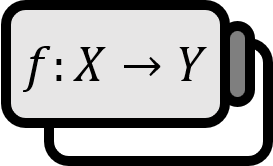Hermite Functions
Definitions
Hermite functions are defined as follows: $$ \begin{align} y_{n} &= \left( D-x \right)^{n} e^{-\frac{x^{2}}{2}} \\ &=e^{\frac{x^{2}}{2}} D^{n} e^{-x^{2}} \end{align} $$ where $D=\frac{d}{dx}$ is the differential operator.
Description
Hermite functions are solutions to the differential equation $$ y_{n}^{\prime \prime}-x^{2}y_{n}=-(2n+1)y_{n},\quad n=0,1,2,\cdots $$ and represent the solution to the one-dimensional harmonic oscillator Schrödinger equation in physics, i.e., the wave function of a one-dimensional harmonic oscillator. $(1)$ can be obtained directly by solving the differential equation. That $(2)$ is identical to $(1)$ can easily be shown through the following theorem.
Theorem
For any $f(x)$, $$ \begin{align} (D-x)^{n}f(x)=e^{\frac{x^{2}}{2}}D^{n}\left[ e^{-\frac{x^{2}}{2}}f(x) \right] ,\quad n=0,1,2,\cdots \end{align} $$ holds.
By substituting $f(x)=e^{-\frac{x^{2}}{2}}$, it can be shown that $(1)$ and $(2)$ are identical.
Proof
Part 1 Proof for when $n=0$ $$ (D-x)^{0}f(x)=f(x)=e^{\frac{x^{2}}{2}}D^{0}\left[ e^{-\frac{x^{2}}{2}}f(x) \right] $$
Part 2 Proof that if it holds for $n$, it also holds for $n+1$
Assuming it holds for $n$, then for $n+1$ the right side of $(3)$ is $$ \begin{align*} e^{\frac{x^{2}}{2}}D^{n+1} \left[ e^{-\frac{x^{2}}{2}}f(x) \right] &=e^{\frac{x^{2}}{2}}D^{n} D\left[ e^{-\frac{x^{2}}{2}}f(x) \right] \\ &=e^{\frac{x^{2}}{2}}D^{n} \left[ -xe^{-\frac{x^{2}}{2}}f(x) +e^{-\frac{x^{2}}{2}}Df(x)\right] \\ &=e^{\frac{x^{2}}{2}}D^{n} \left[ e^{-\frac{x^{2}}{2}}(D-x)f(x) \right] \end{align*} $$ Substituting with $(D-x)f(x)=g(x)$ yields $$ \begin{align*} e^{\frac{x^{2}}{2}}D^{n+1} \left[ e^{-\frac{x^{2}}{2}}f(x) \right] &=e^{\frac{x^{2}}{2}}D^{n} \left[ e^{-\frac{x^{2}}{2}}(D-x)f(x) \right] \\ &=e^{\frac{x^{2}}{2}}D^{n} \left[ e^{-\frac{x^{2}}{2}}g(x) \right] \\ &= (D-x)^{n}g(x) \\ &= (D-x)^{n}(D-x)f(x) \\ &= (D-x)^{n+1}f(x) \end{align*} $$ The third equality holds since we assumed it holds for $n$.
Part 3.
As it holds for both $n=0$ and $n$, it consequently holds for $n+1$ by mathematical induction, thus valid for all $n=0,1,2,\cdots$.
■
